UTS healthcare simulation provides an immersive, innovative, and rigorous learning journey for our nursing and midwifery students. This authentic experience encourages critical thinking, hones clinical skills, and fosters a commitment to patient safety and the best patient outcomes.
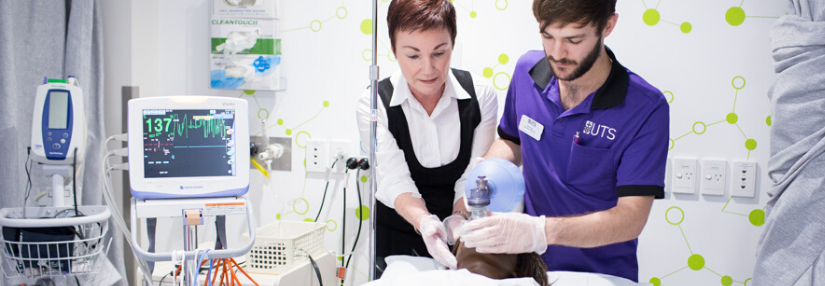
Nursing and midwifery students learn in technology-rich environments with access to some of the best simulation facilities in Australia.
Clinical placements are undertaken across a wide range of metropolitan, regional, rural and international settings.
- Nursing students participate in clinical learning experiences in acute, mental health, aged care and primary health settings, caring for people across the life span and practising both their technical and non-technical skills.
- Midwifery students attend placements in some of the best maternity services in NSW supported by skilled midwives and doctors and learning about the care of women during pregnancy, labour and up to six weeks post-partum.
Nursing simulation facilities virtual tour:
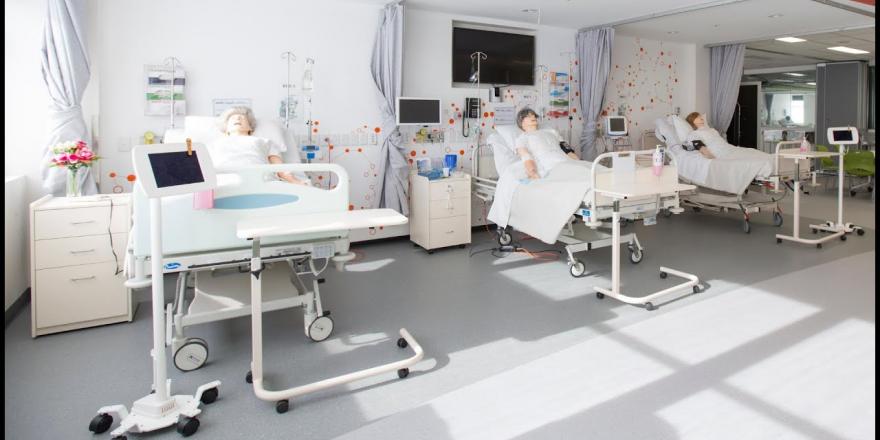
Finbar: [00:00:03] Hi, welcome to the UTS Faculty of Health. Thank you so much for joining our nursing lab tour. On this level there are 16 clinical labs and eight simulation bays for our nursing and midwifery students.
Jenivy: [00:00:14] And here we're standing outside our clinical administration unit, who organise students' clinical placements in health care settings, like hospitals, aged care and community settings.
Finbar: [00:00:25] Let's head over the bridge to have a look at our facilities used for our nursing students.
Finbar: [00:00:29] Here is our first stop, a medical surgical nursing lab.
Jenivy: [00:00:40] Our labs are set up to look and feel exactly like hospitals, aged care facilities and primary health care services. The setup is flexible and there are generally two areas: the classroom area and the simulation area. In the simulation area of five to six bed spaces.
Finbar: [00:00:58] Between the labs is a preparation and equipment room. During class we access equipment we need for different nursing procedures.
Jenivy: [00:01:05] Back in the lab we have manikins to simulate patients.
Finbar: [00:01:09] Many of them are robotic and they have different levels of authenticity, or ability to mimic real-life patients. Some can simulate coughing, vomiting, perspiring, fitting and shivering. They can bleed or simulate a cardiac or respiratory arrest. They can speak, cry and groan so we can tell how they are feeling, just like a real-life patient.
Jenivy: [00:01:32] Simulated-based learning also involves role playing, where actors, people with lived experience, students and teachers all engage in clinical scenarios. These experiences help us to develop communication, empathy and teamwork skills, which are critical to good nursing.
Finbar: [00:01:50] Let's go meet one of our patients, SimMan.
Lily: [00:01:52] When you look around our patient's bed, you'll notice a lot of high-tech equipment. The large LCD screen can show data and scans such as blood results and X-rays. The monitor shows the patient's heart rate, oxygen saturations, temperature and blood pressure. Anything a student does to treat the manikin will be mirrored in their observations. So if they give blood pressure medicine, the manikin's blood pressure will change in response.
Lily: [00:02:16] On the ceiling are two microphones to capture what people are saying when they're working in this bed space. Three cameras reflect what's happening and can be viewed or saved in the control room for students to reflect on and learn from after the simulation.
Jenivy: [00:02:27] We've now entered the control room behind the one way mirror. It's the working hub for many simulated experiences.
Finbar: [00:02:36] The instructor PC shows the patient monitor screen. It controls the manikin and the responses triggered by students when they provide patient care. An instructor can direct the simulation from here as speaking as a patient through the manikin, or they can talk to the students via the speaker above the bed space.
Jenivy: [00:02:54] What happens in the control room is designed to ensure that simulations are realistic clinical scenarios so that students can learn in a really immersive way.
Finbar: [00:03:04] Now let's go have a look at one of our paediatric wards.
Michelle: [00:03:08] This space mimics a children's hospital setting. Nursing students learn about paediatrics throughout their degree, and they can also pick a paediatric elective in their third year. The manikins in here range from newborn to 12 years, but they have the same range of features as adult manikins. Paediatric processes can be complex, and one of the most important nursing skills is to administer medication correctly, because children's body weight is variable and much lower than adults', medication calculation is essential.
Lily: [00:03:41] Hi again. This is the perioperative nursing lab. You'll see that we have an operating theatre set up in here. In third year, nursing students can select perioperative nursing as an elective.
Jessica: [00:03:51] And this particular space is called the community room. It's flexible and can be used to simulate primary health care consultations, mental health nursing visits, care of an elderly person in their home and more.
Jenivy: [00:04:03] The last lab we'll visit today is this one, the practice lab.
Finbar: [00:04:08] This is where we can book in additional practice of our clinical skills.
Jenivy: [00:04:11] And build our confidence before clinical placements and assessments.
Finbar: [00:04:15] On our way out we'll take you past the student kitchenette.
Finbar: [00:04:18] In the kitchen, we have a fridge, freezer and microwave to be used by students at any time.
Jenivy: [00:04:25] And now we'll see our Health student computer and printing area. There's plenty of desks and bookable meeting rooms on this level, which makes it a popular place for group work and independent study.
Finbar: [00:04:40] Thanks so much for joining our tour. We hope you enjoyed gaining insight into being a nursing student at UTS.
Jenivy: [00:04:46] See you at UTS soon.
Midwifery simulation facilities virtual tour:
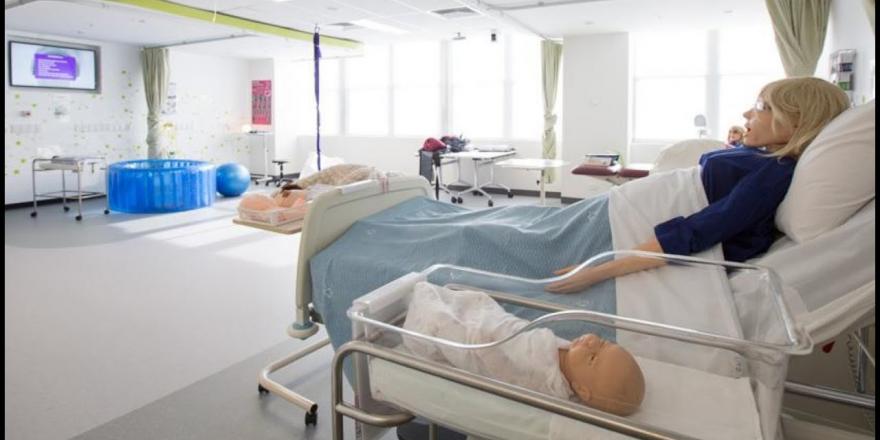
Josey: [00:00:04] Hi, welcome to UTS Faculty of Health. Come join us for our midwifery lab tour.
Jacqueline: [00:00:07] Let's head in and have a look at the clinical facilities available for UTS midwifery students.
Josey: [00:00:19] This is a midwifery learning space where most of our practical classes are. We can simulate environments where midwives practice, such as the home, hospital and emergency care settings. We do specific midwifery clinical skills and simulate normal and complex births. The simulation resources let us reproduce a range of midwifery scenarios during the pregnancy, labour and birth and postnatal care period.
Jacqueline: [00:00:41] The lab is an ideal place to practice as it accurately represents hospital and community settings so you can safely make mistakes here and learn from them. We have a few different pieces of equipment here, such as the birth bath, the stool, the rope, the beanbag and also manikins.
Jacqueline: [00:00:58] And the Resuscitaire. An open warmer that can be used after birth to help the baby if they need help breathing or to be resuscitated. It is also used for sick premature and full term babies to keep them warm when they need to be nursed in the intensive care.
Josey: [00:01:14] We have birthing simulators and manikins which can actually birth a baby. SimNewB can display symptoms of respiratory distress and realistic breathing. As a midwife we'll look after the mother and baby up to six weeks post-natal.
Jacqueline: [00:01:27] Connected to this lab is a scrub room with wash bay, storage and prep area.
Josey: [00:01:39] Let's take you to our clinical teaching and examination room. This room can be used for activities such as simulated community antenatal visits. It can be used as a women's health or diabetes clinic or another health setting.
Jacqueline: [00:02:00] Now we're in a space called the community room. This concept lab is a flexible space. The space can be set up for a variety of different midwifery scenarios. It can be used for situations such as home visits, home births, alternative births or antenatal and postnatal appointments.
Josey: [00:02:19] It's important to mention that not all our learning happens in labs. There's a lot of theory, anatomy and physiology and critical thinking. We also have tutorials in classrooms to learn non-technical skills such as communication, collaboration and teamwork, which are essential to midwifery practice.
Jacqueline: [00:02:34] Just across the way is our student computer area.
Jacqueline: [00:02:40] This is the computer area. Health students can access the computers and printers every day from 8.00am until 10pm.
Jacqueline: [00:02:49] There's also plenty of desks and a number of bookable meeting rooms across this level, making it a popular space for group work and quiet independent study.
Josey: [00:03:01] On our way out, we'll take you past the student kitchenette where we've got a fridge, freezer and a microwave for students to use at any time.
Josey: [00:03:14] Well thank you so much for joining our tour. We hope you've enjoyed this insight into being a midwifery student at UTS.
Jacqueline: [00:03:19] See you at UTS soon.
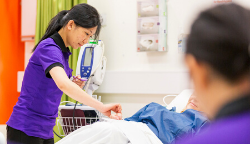
Clinical placements
Practice-based learning is at the heart of our health education. Because in our industry, we know nothing beats practice.
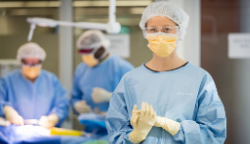
Simulation-based learning experiences
UTS nursing and midwifery students participate in authentic clinical scenarios that would normally only be encountered in real clinical settings.
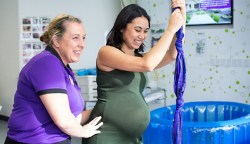
Simulation facilities
UTS simulation facilities and clinical skills laboratories were purpose-built and designed to create engaging and exciting learning opportunities.

